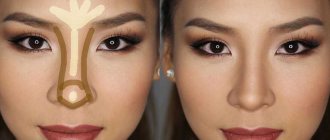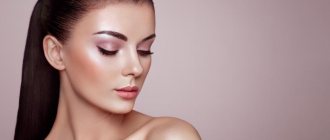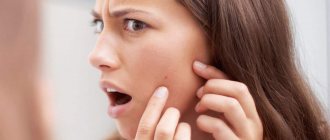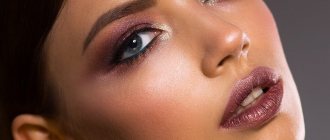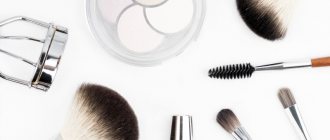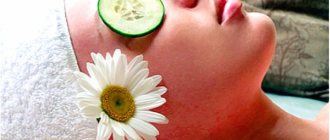What's on the package?
When it comes to makeup against acne scars, it’s not just the “how” that’s important, but also the “what”: the products you use should be non-comedogenic and also suitable for sensitive skin. That is, as “gentle” and soft as possible. Then they will not provoke the appearance of new inflammations. Do you want to not just disguise scars, but get rid of them completely, forever? Ingredients such as licorice extract and vitamin C will contribute to this - they help fight hyperpigmentation, brightening the skin.
How to hide acne without makeup
The use of masking agents on non-healing surfaces does not always solve the problem. Correction with cosmetics can lead to the formation of scars. Although it is difficult to improve the condition of your skin and hide acne on your face without foundation, you can try to cope with rashes without makeup.
There are folk recipes that reduce the appearance of rashes, acne and inflammation on the skin.
Spot treatments with products containing salicylic acid and sulfur give a good effect.
They cleanse overnight, tighten pores, and eliminate blemishes on the skin. Pharmacies and cosmetics stores have special medicinal products that quickly get rid of rashes and acne.
Cosmetologists recommend the following ways to eliminate acne without makeup:
- Take an ice cube and wrap it in a napkin. Apply to the problem area for 10–15 minutes. An ice compress has a vasoconstrictor effect and reduces inflammation.
- Apply a few drops of Visine to a cotton swab and place in the freezer for an hour. Then apply to the pimple and hold for 5 minutes. The drug does not eliminate the cause of acne, but it narrows the pores and removes redness.
- Toothpaste helps make pimples less noticeable. Treat the tubercle with calendula tincture. Spread a thick layer of paste on it. After an hour, rinse with cold water and apply moisturizer.
Stippling
How to apply foundation with acne scars? Makeup artists advise following this rule: adjust the density depending on the area of the skin. “Clean” areas do not need to be covered with a thick layer of foundation - this is simply not necessary. But the scars themselves can be used for better camouflage. Moreover, it is better to use the stippling technique, that is, “driving” the texture of the product into the skin. To do this, take a convenient egg-shaped sponge and, lightly moistening it with water, begin applying foundation.
Remember that foundations with a radiant effect will not suit you: they will only emphasize the textured heterogeneity of the skin in the area with scars.
Rules for camouflaging acne
To cover up acne on your face without worrying about how you look throughout the day, you must first prepare your skin. To level the surface and adjust the color, you will need special cosmetics. You should pay attention to the choice of brush and sponge (sponge) for applying the compositions. To avoid the growth of bacteria, they must be washed after use.
Skin preparation
To obtain a natural and lasting result, makeup artists advise using well-known techniques:
- Wash your face with warm water, without soap solutions. You can use facial washes, lotions, tonics or wet wipes.
- Gently rub in moisturizer or sunscreen without fragrance, which may cause skin irritation. Choose water-based cosmetics. The oils contained in the composition contribute to severe redness of the spots.
Necessary cosmetics
- Base (primer) . The product creates a beautiful look and protects the skin. A thin layer levels the surface and serves as the basis for high-quality adhesion to decorative cosmetics.
- Concealer (corrector) quickly hides imperfections: acne, age spots, circles under the eyes. A varied palette helps cover all types of pimples.
- Foundation evens out the color.
- The powder adds velvety and naturalness and sets makeup. The use of shiny, shimmering cosmetics if acne exists is only possible in exceptional cases. They highlight temporary flaws.
Is it possible to use foundation for acne?
My dear beauties!!!
It's great to see how you support each other!!! We have truly become a big happy family!
BUT there are still those who have not reported on the test (And half of them don’t have reports... Hey!!! Where have you disappeared???
Maybe you're already tired??? And it’s time for us to finish the marathon???
MAIN POST HERE
So... And now to the topic...
The foundation of makeup is foundation, so it is important to apply it correctly, hiding skin imperfections and avoiding the “mask effect.”
The purpose of foundation is to even out the complexion and texture of the skin, making it radiant and beautiful.
The result of a correctly applied foundation should be perfectly smooth skin on which you can apply decorative cosmetics. Makeup artists claim that 80% of success in applying foundation depends on its choice. Find the product that suits you! Foundation for makeup - how to choose
When choosing a foundation, you need to pay attention to the color and texture.
For skin without noticeable flaws, moisturizing fluid creams are suitable. They apply in a thin layer and barely tint the skin. Liquid foundations are best for those with oily skin; As a rule, they do not contain oil or fat. It’s easy to check: ask for a sample in the store and drop a little cream into the water at home. If the cream can be stirred evenly, it means it is water-based. An oil-containing product forms oily droplets in water. Foundation for makeup according to skin type Oil-based foundations with moisturizing components are necessary for dry skin. This product moisturizes the skin throughout the day. If the skin has noticeable imperfections (acne marks, acne, small scars), it is better to use a thick foundation. It covers the skin more densely and fits well. However, this foundation is not suitable for oily skin. If you have this type and are used to a thick foundation, apply a thin layer of translucent powder on top - it will absorb excess oil. When choosing a foundation, pay attention to the lighting; if in the store it is artificial and dim, it is better to take a sample and check the color at home. In bright lighting, the color may look different.
Don't try to test the tone by applying it to the back of your brush. As a rule, the skin there is darker than on the face. If possible, apply a little foundation to your face and wait until it dries (the foundation will darken a little after a minute after applying it to your skin). If you can't decide between two shades, choose the lighter one. Foundation for makeup, if its tone is darker than the skin, creates a “mask effect” on the face. A lighter tone makes the face glow, but it needs to be shaded well. What can foundation do?
Mask strong, medium, weak.
Decide what you want - dense coverage, natural or barely noticeable skin tone. In the latter case, you are better off choosing a cream with a tinting effect rather than a foundation. And if you need strong camouflage in certain parts of the face, take a closer look at correctors. Adapt to skin color. Unfortunately, there is a limit to everything - if you make a big mistake with the color, no amount of adjustment will save you. Mattify, remove oily shine - for a long time or not for so long. It is very difficult to choose a mattifying foundation, since often the chosen one mattifies everyone in the world, but shines on you. Moisturize – this function of foundation is not so noticeable. Hide wrinkles or, conversely, highlight them. Some creams lie on top of wrinkles, while others accumulate in them, revealing your age - and even adding years. To tighten your skin - this is what foundation creams with a lifting effect can do. Mask flaky skin or, conversely, highlight it. Protect your skin from bad weather: wind, frost, snow, cold - any foundation can handle this. Protect from ultraviolet radiation - smart flyers choose a foundation with an SPF of at least 15. And now that the base has been chosen, let’s find out how to properly apply foundation under makeup: ** You need to start from the forehead.
Apply a small amount of product to your forehead with your fingers or a sponge and begin to blend it with quick movements along the massage lines. Do not rub the foundation into the skin; movements should be light. ** Taking a little more product, begin to distribute it lower. Don't forget to apply the product to your eyelids, otherwise your eyes will look tired. ** Next, apply the product to your cheeks and blend it towards your temples. ** Apply a little foundation to the skin of your neck so that the border of your makeup is not noticeable. Under no circumstances apply two layers of foundation - this will make the makeup “heavy” and unnatural. ** Apply a little concealer under your eyes, and touch up pimples and capillaries with a corrector that does not reflect light. First, apply the corrector precisely to the pimple, then gently blend it. Do not try to “plaster over” pimples with foundation, this will make them even more noticeable. Wait for the foundation to dry and then apply loose powder or highlighter to your face. It will make your makeup more durable and give your face a matte finish. The right foundation for makeup is effective and at the same time invisible makeup. You have already learned how to choose a foundation and how to apply it correctly. Now your skin is perfect, your face is glowing - you can experiment! Face powder
There are several types: 1. Loose face powder. As a rule, such powder is applied in a thin layer and does not make the face “overloaded” with foundation. Apply with a powder puff or wide brush. However, it is only suitable for use at home, since it takes up a lot of space and is completely inconvenient for use outside the home. 2. Compact powder. The classic and most common option. It is very compact, has a mirror and a sponge, and easily fits in a handbag. It is convenient to correct “floating” makeup during the day. However, if applied incorrectly, it creates a mask effect on the face. 3. Cream powder. The good thing is that sometimes it can replace foundation. Perfectly mattifies the skin and hides imperfections. But, again, it can be used when applying makeup in the morning at home, since powdering the T-zone during the day will be problematic. 4. Transparent face powder. For many girls with healthy (!) skin, transparent powder is an ideal option. When choosing this powder, you can never go wrong with the shade. It makes the skin velvety and absorbs excess oil. But it does not mask skin imperfections at all (redness, inflammation, pimples), and is not suitable for tanned skin. 5. Bronzing powder (terracotta powder, bronzer powder). An excellent option for tanned skin. Girls choose this powder for the summer because it tints the face (after all, the tan is washed off the face first). However, rich bronzing powder cannot be applied completely over the entire face (only on the forehead, cheeks, chin and nose) and should not be used on pale skin. 6. Powder with reflective particles (shimmering face powder). Gives the face radiance and improves complexion. It is used for evening makeup, since during the day such powder will look out of place and will create the effect of an unnecessary oily sheen on the face. And for evening makeup, such powder should be applied carefully - on the cheekbones, temples, and décolleté. 7. Powder in balls. It is convenient because you can adjust the shade of the powder. For example, if we remove light balls, we get a darker shade; if we remove dark balls, the powder becomes lighter. Most often, such powder contains reflective particles, so it should be applied only to the cheekbones and temples to avoid excess shine. But the disadvantage of this powder is that it poorly masks skin imperfections; it cannot be applied to the entire face. 8. Antiseptic powder or green powder. Designed for problem skin, contains anti-inflammatory additives, masks skin imperfections. The downside is that antiseptic powder must be applied each time with a new cotton swab (to avoid the spread of bacteria), and green powder in addition requires regular flesh-colored powder, since it is applied only to reddened areas. Choosing the color of powder An important rule is that the color of the powder must match the color of your face! As a last resort, choose a powder that is a little lighter so that the face does not look “cut off” from the body. Also keep in mind that loose powder lays on the face almost imperceptibly, but compact powder forms a thicker layer. Therefore, you need to apply it more carefully and carefully. If you doubt your abilities, buy transparent face powder. But remember - it does not mask imperfections at all and is suitable for clean and healthy facial skin. You definitely can't go wrong with the color of the powder if you choose it from the same brand as your foundation. They are usually released in pairs. Knowing the shade of your foundation, you can buy powder of the same or slightly lighter shade. If you choose the color of the powder yourself, then makeup artists advise testing the color on the forehead, bridge of the nose, wrist or chin. But, of course, for this you will have to go to a large cosmetics store that provides samples and testers. How to choose powder depending on your skin condition Of course, for problem skin it is better to choose antiseptic powder or green powder. This way you will kill two birds with one stone - you will heal your skin and disguise imperfections. Compact powder is more suitable for dry skin due to its high fat content. On the contrary, loose powder dries oily skin well. However, the properties of a particular powder vary depending on the manufacturer. The type of powder you choose depends on your goals. Having read what kind of powder there are, I think you have already got your bearings. However: Loose powder is a must-have for home use for many, but in addition to it, women usually purchase compact powder to carry in their purse. Compact powder is indispensable on the road and outside the home. Almost everyone has it. Bronzing, shimmering and powder in balls - as an addition to the main powder, since it does not allow you to completely cover the face, but only certain areas. How to choose powder depending on price? Here it all comes down to your wallet. But keep in mind - really good, high-quality powder will not be cheap (even from online distributors). Thanks to its quality, it will protect your face from oily shine for the whole day, and you will need to “refresh” your makeup a maximum of 1-2 times a day. Cheap powder usually applies unevenly, practically does not protect against oily shine, and you have to correct your makeup with it almost every hour. How to apply face powder Before applying powder, you need to apply day cream and foundation to your face. Then, when the creams are completely absorbed, you can start applying face powder. You cannot apply powder to creams that have not yet been absorbed, as the powder will lie unevenly and in spots. There are several options for applying powder:
1. Puff powder. It looks beautiful in itself, but it’s not always possible to get the right amount of powder with a powder puff. To apply powder with a puff, dip it into the powder compact and touch it to your face. Don't rub! Just apply evenly, not forgetting to powder your neck.
2. Brush. Use a thick, wide brush. Dip it into the powder, lightly shake off the excess and apply the powder to the skin, moving from top to bottom, from side to side. Make sure to apply evenly. Go over your earlobes and neck.
3. Sponge (sponge). A dry sponge perfectly mattifies the T-zone, while a wet sponge masks imperfections and evens out the complexion. Apply powder with light rubbing and circular movements.
4. Cotton pad. Used to apply powder to problem skin to prevent the growth of bacteria. A new cotton pad is used for each application. A few basic rules for using powder: * Never rub powder into your skin too much, otherwise you will ruin the foundation layer and your makeup will look sloppy!
* While powdering, walk several times over the T-zone, which begins to shine first.
* If you notice oily shine on your face during the day, first get rid of it with a cotton swab or napkin, and then powder it. This way your makeup won't float.
* And don't forget to regularly care for your brush, puff or sponge. Once every 1-2 weeks, wash them in warm water and soap (shampoo), then dry them in the shade.
* If you notice that the powder begins to lie unevenly and in spots, replace the tools for applying it. For example, the sponge needs to be replaced every month, the puff - when it turns yellow. *** Harmful components of foundation, powder The purpose of powder, foundation and concealer is to even out the surface of the skin, disguise imperfections and prepare the face for applying subsequent makeup. However, some components of these products can cause an allergic reaction, clogged pores and other unpleasant consequences. Despite the fact that manufacturers strive to reduce the risk of side effects, the likelihood of them still remains. Powder It is clear that the composition of powder varies depending on its type (pressed or loose) and the manufacturer. But there are some common ingredients without which it is impossible to create powder. Among them may be considered harmful: Liquid lanolin (Lanolin Oil). In itself, this product has good moisturizing qualities, but only if it is obtained naturally. Recently, there has been an opinion that more and more manufacturers are using lanolin containing pesticides, and this has a negative effect on the skin. But recent research has shown that allergic reactions to liquid lanolin are extremely rare. People with oily and acne-prone skin should avoid using products containing liquid lanolin, as it clogs pores. Mineral Oil. In fact, there is nothing mineral or organic in this oil - it is the result of refining petroleum products. Oil is extracted from the depths of the Earth, so it is completely natural. There are two opinions about this substance. But we can say for sure: in small quantities, mineral oil can have a beneficial effect on the skin, as it is largely an antioxidant. However, at the same time, an increased content of this substance in cosmetics can lead to clogged pores. They use it wherever possible because it is a cheap product. By the way, baby skin oil is 100% mineral oil. A reason to think and choose something closer to nature for children! Talc. It is a natural component in cosmetic products. Its only drawback is that in powder form it can irritate the lungs. Tocopheryl Acetate. Antioxidant, used to moisturize the skin. In small doses it is harmless. However, in large cases it can cause irritation, peeling and itching of the skin, as well as allergies. Widely used in cosmetics. Liquid foundation Foundation has a slightly different composition than powder, although you can also find mineral oil and silicone. Propylene Glycol is commonly used as a flavoring, humectant, and viscosity control agent. It may cause skin and eye irritation. The safe concentration of this substance in cosmetics can reach 50%. Thimerosal. Used in some cosmetic products and vaccines. Causes allergic reactions, skin irritation may occur, and sometimes has a negative effect on the nervous system. The substance is very toxic - you should avoid it! Benzophenone-z (benzophenone – 3). Used to protect the skin from direct sunlight. May cause allergies and skin irritation. Pore-Clogging Ingredients If you have skin prone to blemishes and blackheads, I encourage you to read labels carefully. The list of such substances is very long, so I will give only a few: Seaweed extract (Algae Extract). Here it should be understood that there are different types of algae. Some have a beneficial effect on the skin, while others, on the contrary, irritate it. Carrageenan. Isopropyl Myristate. Isopropyl Isostearate. Laureth -4 (Laureth 4). Myristyl Myristate. Sodium Lauryl Sulfate. There are a lot of ingredients that can cause irritation and clog pores. However, it should be remembered that most often their content does not exceed the safe limit, and the likelihood of allergic reactions and irritations depends solely on the individual reaction of a person’s skin to these substances.
SO, THE TASK:
1. We continue to follow our water regime, praise ourselves and be beautiful at home (write down the amount of water you drink and compliment yourself). 2. We carry out our daily beauty rituals: Morning: * wash our face * brush our teeth * gently massage our lips with a toothbrush * tone the skin with an ice cube and green tea * restore PH with tonic or lotion * moisturize the face and neck with cream (along the massage lines) * check the shape of the eyebrows and, if necessary, adjust * apply cream/gel/mousse (whatever) to the skin of the eyelids with light patting movements, without stretching the skin, using ring fingers along the massage lines! * intimate hygiene * apply hand cream, don’t forget about elbows!!! Evening: * make-up removal (we cleanse the skin of cosmetics and dust during the day) - along massage lines! * brush your teeth * take a shower (body scrub, hair removal - who needs it))) * restore PH with tonic or lotion (don’t forget about the neck!) * apply nourishing cream to the face and neck (along the massage lines) NO EYELID CREAM NEEDED! Don't forget to wear a headband to protect your hair. * apply balm to the lips * moisturize the skin with body milk (or someone else has cream/lotion/oil) * do exercises on the neck (10-15 minutes a day) * apply nourishing hand cream
* Lubricate your feet with cream at night (every day)
3. Tell us about your makeup base.
Types of correctors
The concealing cosmetic product is produced in various textures and consistencies. In this case, you should distinguish between corrector and concealer. The latter has a lighter texture and can be distributed over large areas, including the area around the eyes, since the product does not dry out the skin. The color scheme, as a rule, has all shades of beige.
Correctors, unlike concealers, have a dense texture with different colors. Each shade is selected taking into account the problem. For example, if you need to hide redness, then you should choose a green shade, to disguise bruises - yellow.
There are several types of facial correctors:
- liquid;
- hard pencil;
- stick;
- cream.
Liquid concealer works well to cover stubborn acne spots, but will not cope with acne. Its structure is similar to foundation. The product is packaged in tubes with a dispenser or in the form of automatic pencils. It is applied all over the face and carefully shaded so as not to create color changes. This product spreads well over the skin and is more suitable for use in professional makeup. Recommended for dry and sensitive skin.
The creamy product adheres well and is easily distributed with a finger, a special brush or sponge.
There are several types of correctors
The pencil is similar to cream, but has a denser consistency. The product hides acne, scars, spider veins, and blemishes well. But the pencil will not disguise acne, which protrudes like tubercles above the surface of the skin. It is recommended to use spot application without rubbing.
Using mineral concealers (dry) you can achieve good results. They are made on the basis of mineral powder and are able to hide acne and redness. In addition, mineral powder eliminates excess sebum and thereby prevents clogging of pores and the appearance of acne. If there are small wrinkles under the eyes, then it is better not to use dry concealer, as they become very noticeable.
Often, such products include various additives that allow you to combat several problems at once, for example, zinc, and then the product will also have a healing effect and eliminate inflammation, salicylic acid, which has disinfectant and drying properties. Therefore, the corrector is applied directly to the area of skin with acne, so as not to harm the healthy dermis.
Special foundations for problem skin: not only mask, but also treat
Special foundation mousses for problem skin are aimed at eliminating not the consequences, but the main skin problems. Their component composition contains not only reflective particles, but also a matting pigment. Such concealing cosmetics are produced using a unique formula. That is why they are able to maintain a sufficient level of skin moisture, prevent irritation or an allergic reaction, and also eliminate oily sheen.
It is recommended to buy medicinal foundations at a pharmacy rather than cosmetic stores.
Pharmacy cosmetic creams do not contain a pronounced odor, and therefore are least likely to cause irritation or provoke the development of an allergic reaction. Everyone has individual problems on their face: increased activity of the sebaceous glands, acne, enlarged pores or a reddish tint. You only need to choose an anti-acne concealing foundation for your skin type. An important component that should be contained in such cosmetics is hyaluronic acid - this must be checked when purchasing cosmetics.


